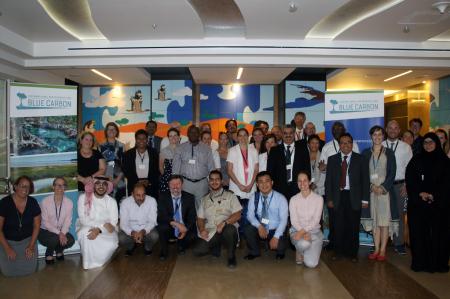From Tuesday 11 July to Thursday 13 July 2017, the Abu Dhabi Global Environmental Data Initiative (AGEDI) hosted the second annual meeting of the International Partnership for Blue Carbon. Announced at COP21 in 2015 by the Government of Australia, the partnership is a consortium of governments, non-profit organisations, and intergovernmental agencies who equip policy-makers with actionable information and knowledge of coastal blue carbon ecosystems (mangrove, tidal marsh and seagrass) for climate change mitigation as well as securing social, economic and environmental outcomes.
Improved management of these ecosystems can enhance food security, secure livelihoods, increase resilience and contribute to delivering Nationally Determined Contributions (NDCs) through carbon sequestration and adaptation. The partnership aims to protect and restore coastal blue carbon ecosystems by building awareness, sharing knowledge and accelerating practical action.
“The UAE is taking the lead on researching its rich coastal blue carbon ecosystems. We have about 14,000 hectares of mangroves, extensive salt marshes and seagrass meadows supporting globally significant populations of dugongs” said Ahmed Baharoon, AGEDI’s Acting Director. “AGEDI with support from the Environment Agency – Abu Dhabi (EAD) and in partnership with the UAE’s Ministry of Climate Change & Environment (MoCCaE) are committed to pursuing national, regional and global goals to ensure blue carbon science is at the forefront of the international effort for natural climate change mitigation. Our role in the International Partnership for Blue Carbon is a sign of this commitment.”
The second annual meeting involved policy and technical discussions from mitigation and adaptation perspectives. It took stock of the international state of play on blue carbon science, policy and on-ground activities, discussed advancements in international policy frameworks relevant to blue carbon and looked at innovative financing avenues available to implement activities more effectively. Attendees included members from international organisations, government representatives from Africa, Europe, America and Asia as well as participants from the private sector and NGOs.
“Australia has one of the largest expanses of coastal wetlands in the world. We have a range of policies in place to conserve these ecosystems and the many migratory and threatened species they are home to. This year Australia has also reported on mangroves and tidal marshes in our National Greenhouse Gas Inventory as part of improved emissions reporting. It is important to work together to share our experiences in conserving these important ecosystems, such as through the Partnership,” said a spokesperson for the Australian Government Department of the Environment and Energy.
Engineer Muna Omran Majed Al Shamsi, Acting Director, Biodiversity Department, Ministry of Climate Change and Environment, said: “In the UAE, we have been working extensively in marine resource conservation, sustainable fisheries, aquaculture and research and development. One particular area of focus has been the protection of our blue carbon ecosystems.
We have been working hard with the Environmental Agency Abu Dhabi, and the Abu Dhabi Global Environmental Data Initiative (AGEDI) and relevant entities to assess the carbon reserves that these systems hold. These studies have helped us identify carbon stocks that are extremely valuable, and reinforce the importance of appropriate conservation measures to protect the blue carbon ecosystems. We know that, if destroyed, these ecosystems will release carbon into the atmosphere and contribute to global warming. For example, it takes four decades for newly planted mangroves to mature and sequester the same amount of carbon as mature mangrove forests.
This is why we have highlighted the importance of conserving and protecting blue carbon ecosystems in our NDC, and it is also why we are proud to be part of this initiative.”
More information on blue carbon, the partnership, the meeting outcomes and future meetings can be found at www.bluecarbonpartnership.org.



